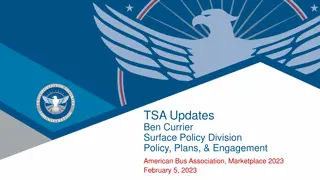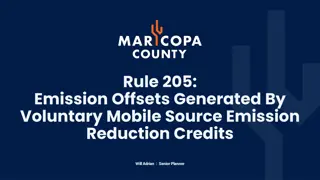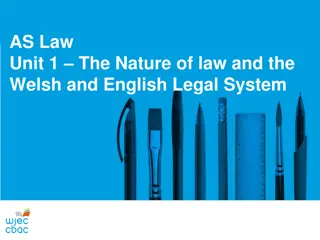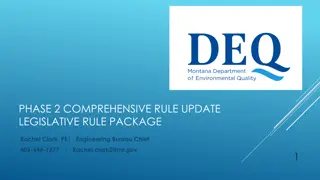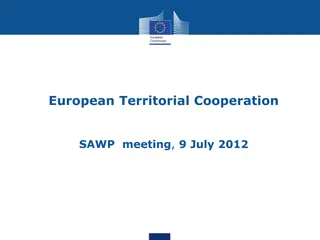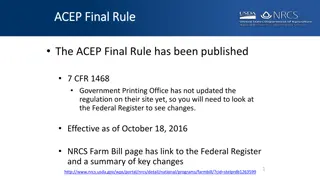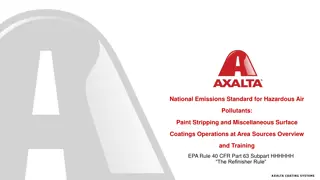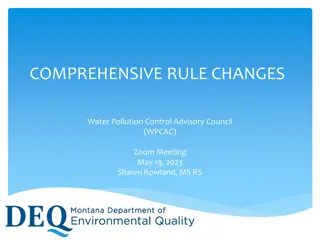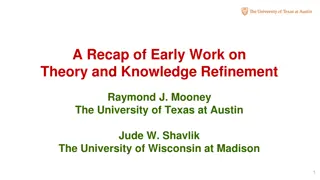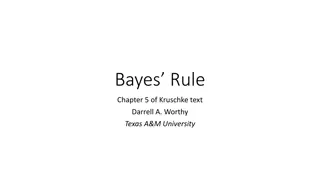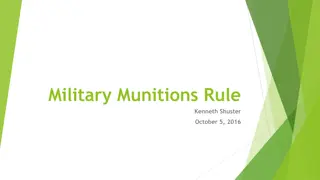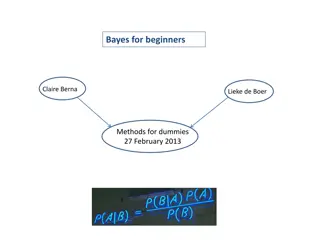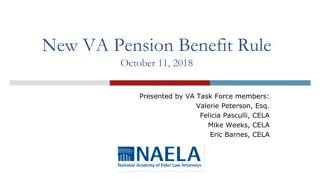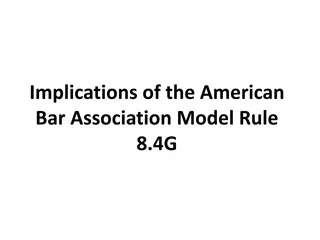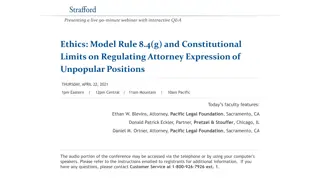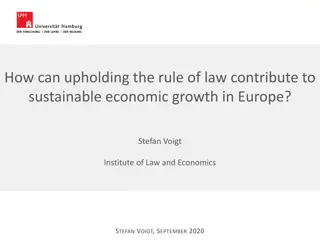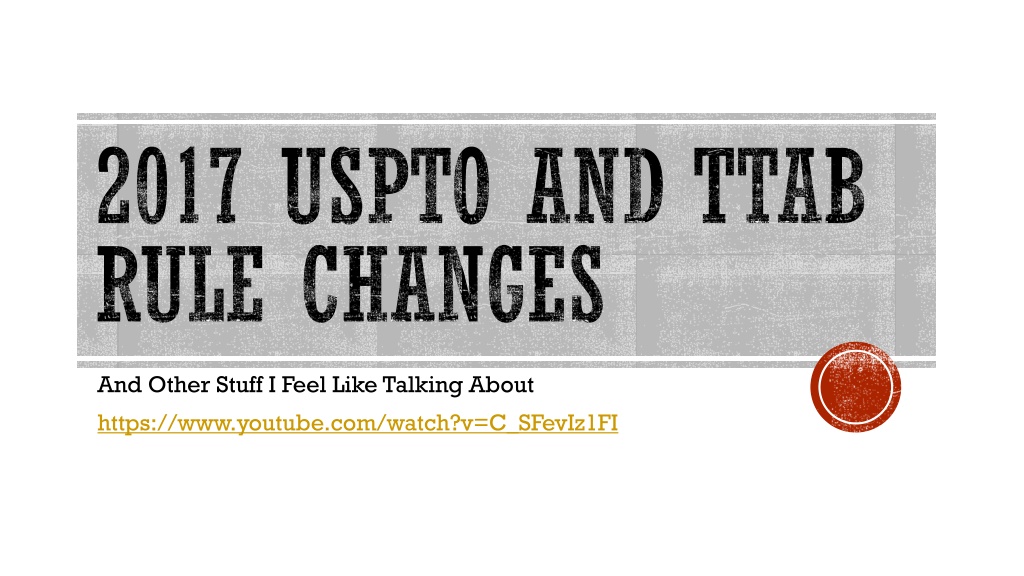
USPTO TTAB Rule Changes 2017 and Filing Fee Updates
Stay informed about the 2017 USPTO and TTAB rule changes affecting filing fees for various applications and requests. Learn about the fee adjustments, new requirements, and upcoming changes in trademark proceedings.
Download Presentation

Please find below an Image/Link to download the presentation.
The content on the website is provided AS IS for your information and personal use only. It may not be sold, licensed, or shared on other websites without obtaining consent from the author. Download presentation by click this link. If you encounter any issues during the download, it is possible that the publisher has removed the file from their server.
E N D
Presentation Transcript
2017 USPTO AND TTAB RULE CHANGES And Other Stuff I Feel Like Talking About https://www.youtube.com/watch?v=C_SFevIz1FI
USTPO HTTPS://WWW.YOUTUBE.COM/WATCH?V=MBS0OWGUIDC Filing an application on paper - $600 instead of $375 and requires petition to director Filing TEAS application - $400 instead of $325 TEAS Plus and RF applications remain the same BUT if you mess something up and can t claim TEAS Plus, $125 instead of $50 Request to divide filed on paper - $200 instead of $100 Renewals on paper - $500 instead of $400 Grace period renewals on paper $200 instead of $100
Section 8 affidavit on paper - $225 instead of $100 Section 8 affidavit online - $125 instead of $100 Section 15 affidavit on paper - $200 instead of $100 New registration certificates, certificates of correction, amendments on paper, statements of use, petitions to the director - $200 instead of $100 Extensions of time to file statement of use -$125 instead of $150 (on paper $225) Renewals, Section 15, new/correction certificates, amendments, statements of use, petitions to the director online no change
TTAB CHANGES COMING SOON TO A CASE NEAR YOU JANUARY 14, 2017 Applies to All Pending Cases Must File Electronically Filing Fees are $400 Instead of $300 ($500 if filed on paper) Extensions of Time to Oppose - $100 for First and $200 for Section ($200 and $300 for paper) Per application, not per Class Already in Effect Revised Protective Order https://www.uspto.gov/trademarks-application-process/appealing-trademark-decisions/standard- documents-and-guidelines-0 Limits to RFP, Interrogatories and RFA 75 apiece May move for good cause to exceed No Longer Need to Serve Complaint Upon Filing Proceedings Automatically Suspended Upon Filing of Dispositive Motions Service by Email Only* Unless parties agree otherwise No More Mail Time All 15 Response Periods Are Now 20 MSJ response periods remain 30 days and reply is now 20 days
Only Get 30 Days to Respond to Discovery Must Serve Discovery Early Enough for Responses to be Served Prior to Close of Discovery* Unless discovery is served before the date the discovery rules come into effect Duty to supplement continues after close of discovery Board has discretion to apply new rules to pending cases and extending the discovery period But no guarantees the Board will be nice to you No Per Se Cap on Extensions of Discovery Period But Board may condition further extensions on good cause shown Motion To Compel Must be Filed Prior to Deadline for First Pretrial Disclosure Motion to Compel Initial Disclosures Must Be Filed Within 30 Days After Deadline for Serving MSJ Motions Must be Served Prior to Deadline for Pretrial Disclosures
TTAB TRIAL CHANGES Testimony Is Taken by Affidavit or Declaration But right to take an oral cross-exam Deposition Transcripts Must be Submitted One Page per Sheet and With a Word Index Hey, the Board reads these! Notice of Reliance Internet materials can be submitted with screenshot with URL and date and time Current copy of information from USPTO databases Pleaded registrations Registrations owned by any party Indicate generally the relevance and associate with one or more issues File of subject application or registration is of record Statements in affidavits or declarations in file history record are not testimony Must File Motion with Pretrial Disclosure to Use Discovery Deposition If Witness Is Not Included in Pretrial Disclosures May Move to Quash Notice of Testimony Deposition or Move to Strike Affidavit or Declaration
THOUGHTS? Rules make the proceedings more opposer/petitioner friendly Don t have to serve complaint Service by email Earlier deadline for when motions to compel can be filed Can t compel initial disclosures unless you do so within 30 days of deadline Faster discovery response deadlines Can t serve discovery on the last day of discovery period https://www.youtube.com/watch?v=yJxCdh1Ps48 Limits(?) on amount of discovery that can be served Testimony by affidavit or declaration puts the onus on the party seeking to cross examine to request (pay for?) deposition
CHRISTIAN FAITH FELLOWSHIP CHURCH V. ADIDAS AG, APPEAL NO. 2016-1296 (FED. CIR. NOVEMBER 14, 2016) [PRECEDENTIAL] Christian Faith Fellowship Church appeals TTAB decision to cancel two registrations for the marks ADD A ZERO and the following design for clothing for lack of use in commerce http://cffczion.org/ Big Bad Adidas was trying to register ADIZERO and was refused based on the Church s registration https://www.youtube.com/watch?v=JNua1lFDuDI
Church had documented sales of two hats to an out of state resident which were held to be de minimis [T]he sale of two ADD A ZERO caps at a minimal cost within the state of Illinois to Ms. Howard, who resides outside the state, does not affect commerce that Congress can regulate such that the transaction would constitute use in commerce for purposes of registration. . . . This sale is de minimis and, under the circumstances shown here, is insufficient to show use that affects interstate commerce. Adidas alternate grounds of failure to function as trademarks and abandonment were not considered
CHECK IT OUT Adidas argued check was inadmissible hearsay Court says nuh-uh business exception and self-authenticating A Church pastor, whose duties included Church recordkeeping, testified that the check was maintained in the Church s records in the normal course of Church bookstore sales, along with the corroborating entry in the bookstore ledger of sales. Adidas argues that the pre-printed address on the check had nothing to do with Church business, and therefore, the check should not have been admissible under the business records exception. We disagree. When a business relies on a document it has not itself prepared, two factors bear on the admissibility of the evidence as a business record: [1] that the incorporating business rely upon the accuracy of the document incorporated[;] and [2] that there are other circumstances indicating the trustworthiness of the document. Id. We hold that the Board did not abuse its discretion in determining that the Church relied on the check, a bank- issued negotiable instrument, as accurate and trustworthy. We also hold that the check is self-authenticating as commercial paper under Federal Rule of Evidence 902(9).
Congresss power under the Commerce Clause is broad. Cited precedent that rejected that there needs to be a percentage of use in interstate commerce Single intrastate sale of French wine constituted use in commerce Single location restaurant can be use in interstate commerce Purely intrastate production of wheat can be regulated by federal statute Two robberies involving marijuana dealers can be prosecuted under the Hobbs Act well, you get the picture Moving to the facts of this case, it is clear in light of the foregoing precedent that the Church s sale of two ADD A ZERO -marked hats to an out-of-state resident is regulable by Congress under the Commerce Clause and, therefore, constitutes use in commerce under the Lanham Act. We reach this conclusion without defining the outer contours of Congress s Commerce Clause powers because the transaction at issue falls comfortably within the bounds of those powers already sketched for us by the Supreme Court. The Lanham Act is a comprehensive scheme for regulating economic activity namely the marking of commercial goods and the use in commerce pre-registration requirement is an essential part of the Act. Lopez, 514 U.S. at 561. Further, it cannot be doubted that the transaction at issue the private sale of goods, particularly apparel, to an out-of-state resident is quintessentially economic. . . . This transaction, taken in the aggregate, would cause a substantial effect on interstate commerce and thus it falls under Congress s Commerce Clause powers.
The Boards rationale that the sale to Ms. Howard was de minimis and thus insufficient to show use that affects interstate commerce is squarely at odds with the Wickard progeny of Commerce Clause cases. Board Op. at *7. In particular, the Board s reasoning contravenes Raich, which expressed that the de minimis character of individual instances arising under a valid statute enacted under the Commerce Clause is of no consequence. 545 U.S. at 17. [I]t makes no difference under our cases that any actual or threatened effect on commerce in a particular case is minimal. Taylor, 136 S. Ct. at 2081 (citing Perez, 402 U.S. at 154); see also Larry Harmon, 929 F.2d at 666. Adidas s argument that the Church must present actual proof that its sale to Ms. Howard directly affected commerce also contradicts precedent. [P]roof that the defendant s conduct in and of itself affected or threatened commerce is not needed. All that is needed is proof that the defendant s conduct fell within a category of conduct that, in the aggregate, had the requisite effect. Adidas would like us to cabin Raich and Taylor to their particular facts, namely to cases involving the market for illegal drugs. But the Supreme Court s elucidation of the Constitutional reach of the Commerce Clause in those cases applies to more than just federal drug regulation. Raich and Taylor apply, and indeed rest on, principles derived from Wickard, which involved the national market for wheat, not illegal drugs. . . . Moreover, there is nothing in these cases themselves to limit the Constitutional precepts and legal tests discussed therein to their facts.
The Board also erred to the extent it relied on In re Cook, United, Inc., 188 U.S.P.Q. 284 (T.T.A.B. 1975), and In re The Bagel Factory, Inc., 183 U.S.P.Q. 553 (T.T.A.B. 1974), for the proposition that an intrastate sale of goods can never be a sale in commerce without the trademark applicant doing something more, such as knowingly directing the movement of goods across state lines. Cook, 188 U.S.P.Q. at 287 88; Bagel Factory, 183 U.S.P.Q. at 554 55. These Board cases have been the source of confusion in our use in commerce doctrine. Doubt has been cast on the vitality of the Bagel Factory holding, with commentators noting that under the modern interpretations of the Commerce Clause . . . it would appear that a sale or delivery does not have to cross a state line in order to affect commerce. 3 J. Thomas McCarthy, McCarthy on Trademarks and Unfair Competition 19:123 (4th ed.) (footnote omitted). Others have similarly explained that, in Cook, the PTO was operating under a different standard than the one provided in the Supreme Court s Commerce Clause precedent and have concluded that, especially after Larry Harmon, not only is the PTO s perspective [as stated in Cook] no longer appropriate nor correct, it is no longer the law. Peter C. Christensen & Teresa C. Tucker, The Use in Commerce Requirement for Trademark Registration After Larry Harmon Pictures, 32 IDEA 327, 332, 341 (1992). To the extent Cook and Bagel Factory assert that the Lanham Act requires commercial activity, whether for goods or services, beyond that which is sufficient for Congress to regulate commercial activity under the Commerce Clause, they are incorrect. It is beyond dispute that the definition of commerce in the Lanham Act means exactly what the statute says, i.e. all commerce which may lawfully be regulated by Congress. Because one need not direct goods across state lines for Congress to regulate the activity under the Commerce Clause, there is likewise no such per se condition for satisfying the Lanham Act s use in commerce requirement.
COSTS TO APPELLANT. Adidas should have added a zero to that settlement offer But Church is not out of the woods yet For the foregoing reasons, we reverse the Board s cancellation of the Church s ADD A ZERO marks for not using them in commerce before federally registering them and remand for the Board to address Adidas s other cancellation grounds. Specimen of use for both ADD A ZERO applications:
WISE F&I, LLC; FINANCIAL GAP, ADMINISTRATOR LLC; VEHICLE SERVICE ADMINISTRATOR LLC; AND ADMINISTRATION AMERICA LLC V. ALLSTATE INSURANCE COMPANY, OPPOSITION NO. 91226028 (PARENT) AND OPPOSITION NO. 91226029 (SEPTEMBER 23, 2016) [PRECEDENTIAL]. Applicant filed applications to register the marks MILEWISE2 and ALLSTATE MILEWISE, respectively, in standard character form for [i]nsurance services, namely, writing and underwriting of property and casualty insurance and providing ancillary services thereto, namely, administration and claims adjustment, in International Class 36. Opposers jointly filed notices of opposition against both applications, in each case claiming likelihood of confusion under Trademark Act Section 2(d), 15 U.S.C. 1052(d)
Opposers have alleged prior use and registration of the following marks, which collectively identify services including automotive finance, insurance, and warranty services, and identity theft insurance, among others: Reg. No. 4249179 for the mark WISE F&I (standard character form), owned by Wise F&I, LLC Reg. No. 4778223 for the mark ONWISE (standard character form), owned by Wise F&I, LLC Reg. No. 2800305 for the mark TIREWISE (typed drawing form), owned by Vehicle Service Administrator LLC Reg. No. 4372307 for the mark WISECARE (standard character form), owned by Vehicle Service Administrator LLC; Reg. No. 2363547 for the mark GAPWISE (typed drawing form), owned by Financial Gap Administrator LLC; Reg. No. 3611703 for the mark ID THEFTWISE (standard character form), owned by Administration America LLC Reg. No. 3086022 for the mark THEFTWISE (typed drawing form), owned by Administration America LLC; Reg. No. 2745080 for the mark ETCHWISE (typed drawing form), owned by Administration America LLC. Opposers allege that Administration America LLC, Financial Gap Administrator LLC, and Vehicle Service Administrator LLC are all subsidiaries of OpposerWise F&I, LLC.
Applicant contends that as a threshold matter a Section 2(d) claim predicated on a family of marks is not available to Opposers because Opposers pleaded marks and registrations are not owned by a single entity, and thus, as a matter of law, the common characteristic of the alleged family of marks cannot identify a common source of origin. Applicant further contends that Opposers have not alleged facts sufficient to support their allegation of ownership of a family of marks because Opposers have not alleged that the common characteristic of the marks is distinctive and that the marks have been used and promoted in such a manner that the public associates not only the individual marks, but the common characteristic of the family, with a single source. Additionally, Applicant argues that Opposers Section 2(d) claim is predicated solely on an allegation of likelihood of confusion regarding the alleged family of marks, and not on the individual marks. It is Applicant s position that if Opposers claim of ownership of a family of marks is dismissed, then the oppositions must be dismissed in their entireties because Opposers have not asserted the individual marks as independent bases for the Section 2(d) claim. Opposers contend that the family of marks doctrine does not require that the marks all be owned by one entity, but only that the marks share a common origin where the shared characteristic of the marks is recognized as indicative of a common origin of the goods [or services].
The Board has not considered Applicants arguments that Opposers will be unable to prove that the pleaded marks and registrations constitute a family of marks. The purpose of a motion to dismiss is to test the sufficiency of the complaint, not to decide the merits of the case. A plaintiff must plead ownership of a family of marks in its complaint in order to rely on the marks as a family as a basis for sustaining the opposition at trial or in a motion for summary judgment. The threshold issue is whether Opposers are entitled to allege a family of marks as a basis for a Section 2(d) claim when Opposers pleaded marks and registrations are not all owned by a single legal entity.
WELLA A.G. CASES, IN RE WELLA A.G., 787 F.2D 1549, 229 USPQ 274 (FED. CIR. 1986) (WELLA I) AND IN RE WELLA A.G., 5 USPQ2D 1359, 1361 (TTAB 1987) (WELLA II), REV D ON OTHER GROUNDS, 8 USPQ2D 1365 (FED. CIR. 1988) The question is whether, despite the similarity of the marks and the goods on which they are used, the public is likely to be confused about the source of the hair straightening products carrying the trademark WELLASTRATE. In other words, is the public likely to believe that the source of that product is Wella U.S. rather than the German company or the Wella organization. If the Wella family of marks connotes to consumers only a single source for all Wella products, namely the Wella organization, it is difficult to see how Wella A.G. s use of the mark WELLASTRATE would cause confusion as to source because of Wella U.S. s use of other Wella marks. [A] determination must be made as to whether purchasers would believe that particular goods or services emanate from a single source, when in fact those goods or services emanate from more than a single source. Clearly, the [Federal Circuit] views the concept of source as encompassing more than legal entity. Thus, in this case, we are required to determine whether Wella A.G. and Wella U.S. are the same source or different sources. If we find that the two entities are the same source, there could, of course, be no confusion as to source, and the refusal under Section 2(d) may not stand. The question of whether Wella U.S. and Wella A.G. are the same source is a question of fact.
WELL, WELL, WELL We agree with Opposers that in the context of the family of marks inquiry, the concept of common origin ( source ) may encompass more than one entity. In view of the Wella I and Wella II decisions, it logically follows that related entities can rely on a family of marks as a basis for a Section 2(d) claim notwithstanding the fact that the pleaded marks are not all owned by a single entity if the complaint contains sufficient factual allegations that they are related, and that there is unity of control over the pleaded marks such that the marks are indicative of a single source, and all of the other elements for pleading a family of marks are satisfied With respect to unity of control, the Board stated in Wella II that: Besides the existence of a legal relationship, there must also be a unity of control over the use of the trademarks. Control and source are inextricably linked. If, notwithstanding the legal relationship between entities, each entity exclusively controls the nature and quality of the goods to which it applies one or more of the various WELLA trademarks, the two entities are in fact separate sources. Wella II, 5 USPQ2d at 1361.
Here, Opposers plead only that Opposers Administration America LLC, Financial Gap Administrator LLC, and Vehicle Service Administrator LLC are each subsidiaries of [Opposer] Wise F&I. . . . Opposers have failed to allege that the use of the pleaded marks and the nature and quality of the services sold under the pleaded marks by the different Opposers are controlled by one of the Opposers such that the marks identify a single source for all of the services identified by the respective marks. What establishes unity of control depends on the circumstances in every case. In re Wacker Neuson SE, 97 USPQ2d 1408, 1413 (TTAB 2010). Pursuant to Wella II, in addition to the existence of a legal relationship, there must also be a unity of control over the use of the marks and the nature and quality of the goods or services to which the marks apply. Wella II, 5 USPQ2d at 1361. In Wella II unity of control was found to exist because the applicant, Wella AG, owned substantially all of the outstanding stock of the registrant, Wella (USA), and thus control[led] the activities and operations of Wella U.S., including the selection, adoption and use of the trademarks. Id. We find that an allegation of unity of control is a necessary element for asserting a claim under Section 2(d) on the basis of a family of marks based on marks owned by separate legal entities. Because Opposers have not made such an allegation, the notice of opposition fails to state a Section 2(d) claim based on the ownership of a family of marks.
We next consider Applicants contention that apart from the ownership issue, Opposers have not set forth in the notice of opposition facts sufficient to support the allegation that the pleaded marks constitute a family. Applicant correctly cites authority for the proposition that [s]imply using a series of similar marks does not of itself establish the existence of a family. To assert ownership of a family of marks a plaintiff must allege, and ultimately prove: (1) prior use of marks sharing a recognizable common characteristic; (2) that the common characteristic is distinctive (i.e., not descriptive or highly suggestive or so commonly used in the trade that it cannot function as the distinguishing feature of any party s mark); and (3) that prior to the defendant s first use (or constructive first use) of its involved mark, plaintiff s marks have been used and advertised in promotional material or in everyday sales activities in such a manner as to create common exposure and thereafter recognition among the purchasing public such that the common characteristic is itself indicative of a common origin of the goods or services. Here, Opposers allege prior use and ownership of marks sharing the common characteristic WISE. . . . However, Opposers claim is factually deficient because Opposers have failed to plead that the common element WISE is distinctive. . . . Additionally, Opposers have failed to adequately plead that their marks, or a number of them, have been used and advertised in such a manner that the public associates not only the individual marks, but the common characteristic of the putative family, with a single source. . . . Because Opposers have failed to allege all of the necessary elements of a family of marks claim, the notice of opposition fails to state a claim upon which relief can be granted.
MUCH ADO OVER NOTHING. Board also found that opposer did not plead registrations individually Opposers allegations regarding their pleaded marks and registrations are set forth in what amounts to a single set of broad allegations. . . . If Opposers avail themselves of the opportunity to file amended notices of opposition, as provided for at the end of this order, then in the amended notices Opposers must set forth each pleaded mark and registration in a separate numbered paragraph so that Applicant can separately admit or deny Opposers allegations with respect to each one. Opposer filed Amended Notice of Opposition still based on family of marks and also on the individual marks Applicant has answered.



